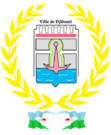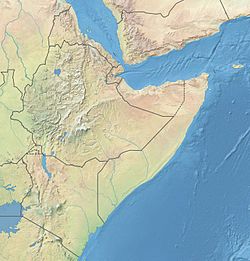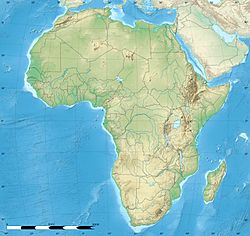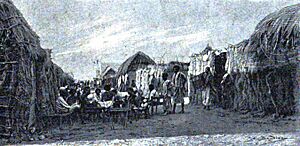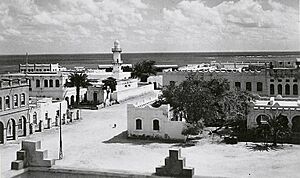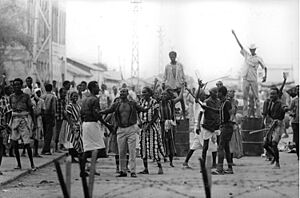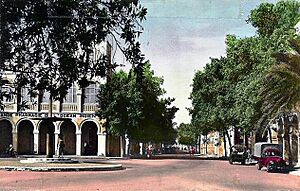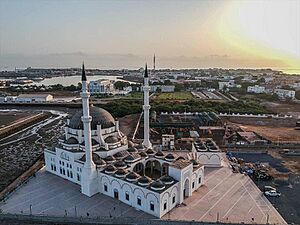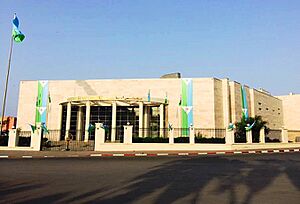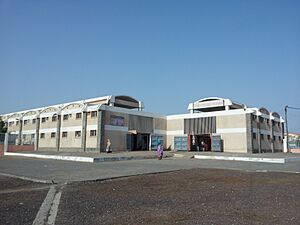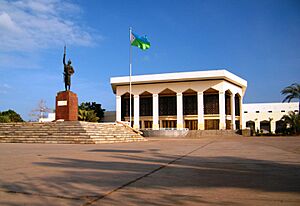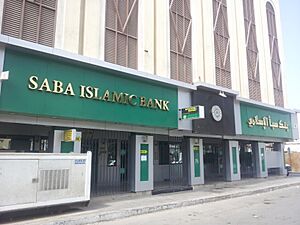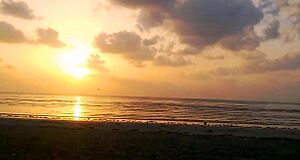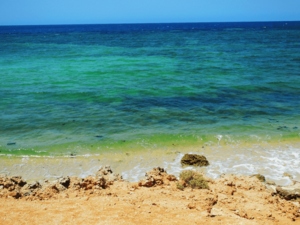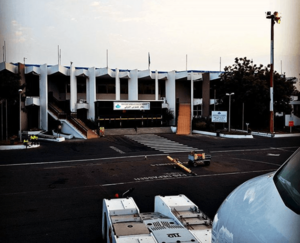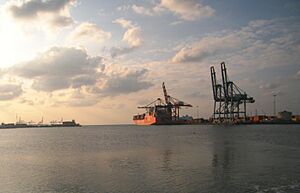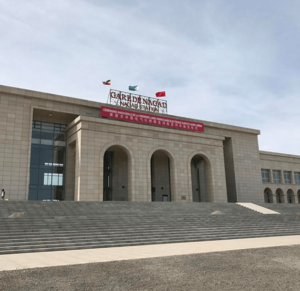Djibouti City facts for kids
Quick facts for kids
Djibouti
|
||
|---|---|---|
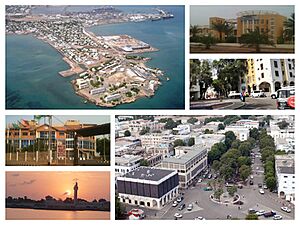
Heron and port, MES-CERD, Rue Marchand, Hotel Casino Impérial, Sunrise near Venise road, Place Marchand
|
||
|
||
| Nickname(s):
Pearl of the Gulf of Tadjoura
|
||
| Country | ||
| Region | Djibouti Region | |
| Founded | 1888 | |
| Districts | 35 | |
| Area | ||
| • Total | 200 km2 (80 sq mi) | |
| Elevation | 14 m (46 ft) | |
| Population
(2024 census)
|
||
| • Total | 776,966 | |
| • Density | 3,900/km2 (10,100/sq mi) | |
| Time zone | UTC+03:00 (East Africa Time) | |
| • Summer (DST) | (Not Observed) | |
| Area code(s) | +253 | |
| ISO 3166 code | DJ-DJ | |
| HDI (2018) | low |
|
Djibouti (also known as Djibouti City) is the capital city of the country Djibouti. It is located right on the coast, next to the Gulf of Tadjoura.
About 780,000 people live here, which is most of the country's population! The city was started in 1888 by the French. They leased the land from local leaders. For a long time, it was the capital of French Somaliland. Later, it became the capital of the French Territory of the Afars and Issas.
Contents
History of Djibouti City
There is proof that people lived on the eastern coast of Djibouti a very long time ago. This was during the Bronze Age.
From 1862 to 1894, the land north of the Gulf of Tadjoura was called Obock. It was ruled by local Sultans from the Issa clan and Afar people. France made agreements with these leaders to gain a foothold in the area. In 1888, France and Britain set the border between their colonies. This left the southern coasts of the Gulf of Tadjoura under French control. This area included a special peninsula called Ras Djibouti. It was a very important spot for France's plans in Africa and Asia. Soon, this place became a starting point for trade routes to Harar.
The French then founded Djibouti in 1888. It was on a part of the coast where no one lived before. People thought it was better than Obock because of its good harbor and closeness to Harrar. A small village called Ambouli was nearby. In 1896, Djibouti became the capital of French Somaliland.
France wanted to protect its trade routes to Madagascar and Indochina. They wanted to keep other European countries from taking over. The city grew a lot after the Franco-Ethiopian Railway was built. By 1895, Djibouti had 5,000 people. Many nomads from the Issa and Afar groups settled here. They became dockers and helped build the city. French, Yemeni, Egyptian, Greek, Armenian, and Italian traders came to Djibouti. The rich farming area of Ambouli also grew with its date palm farms.
In 1896, Léonce Lagarde became the first governor of the French Somali Coast. By the early 1900s, Djibouti had 10,000 people. It was seen as a major port in the region. Its main job was to supply French ships going to Indochina or Madagascar.
The Franco-Ethiopian Railway helped Djibouti's trade grow quickly. It soon became more important than the old caravan trade with Zeila. Djibouti became a center for goods from southern Ethiopia and the Ogaden. This included Harari coffee and khat. In 1933, Djibouti was the first town in French Somaliland to get electricity. A new deep-water port was built, which greatly increased ship and rail traffic. An oil terminal was added in 1937.
During Second World War, Djibouti was attacked by Italian planes in June 1940. Many people in the town were killed. After France fell, the colony was ruled by the pro-Axis Vichy government. The Allied forces then started a blockade of French Somaliland. This led to very difficult times in the city. There were food shortages, and many people suffered. Many townspeople left for the countryside. The local people called this time "carmii," which means a type of grain usually for cattle, but used as human food during the worst of the shortages.
In December 1941, Japan declared war, which gave the colony a short break. The Royal Navy had to move most of its ships from the blockade. The rule of the French official Nouailhetas was very harsh. He was removed from his position in October 1942. On December 28, 1942, French Somaliland was freed. André Bayardelle became the first governor under the Free French government.
In 1946, Djibouti became an overseas territory. A local assembly was elected. In 1956, a government council was created to manage local matters. New rules were made to help the deep-water port grow. It became a free port and could handle 2,000 ships each year. In 1948, a new currency was created, linked to gold and convertible to dollars.
In 1966, the French President, Charles de Gaulle, visited. His visit was met with protests. Because of this, de Gaulle ordered another vote. On March 19, 1967, a vote was held to decide the future of the territory. The results showed people wanted to stay connected to France, but with more freedom. However, there were reports that the vote was unfair. The results caused unrest and some deaths.
The population of Djibouti grew quickly. In 1947, there were about 17,000 people. By 1949, the city had a clear plan. It had a grid of streets, small homes in large blocks, and central open spaces. Cultural buildings were grouped together in a civic center. Djibouti City then became the main city for the French Territory of the Afars and Issas.
When Djibouti became independent on June 27, 1977, the city had over 110,000 people. Since then, it has been the main capital for government and business in the Republic of Djibouti.
Climate
Djibouti has a very dry climate. It is known for its very hot, dry summers. Winters are warm with a little more rain. Most of the rain falls between October and May. The city gets about 163.5 millimeters (6.4 inches) of rain each year.
Average high temperatures are around 29°C (84°F) in December, January, and February. In July, they can reach about 42°C (108°F). There are two main seasons. A hot, dry season lasts from May to October. A cooler season with more rain lasts from November to April.
In summer, temperatures often go above 40°C (104°F). The air is very dry then. The city gets a lot of sunshine, usually 8 to 10 hours a day all year. It's a bit less sunny during the rainy season. This is when there can be some coastal fog and more clouds. Sometimes, there are unusual heavy rains. For example, 224 millimeters (8.8 inches) fell in November 1949.
Winters have average nighttime temperatures of 21°C (70°F). Daytime highs are around 29°C (84°F). There are very few days without sunshine. Even in winter, there are many clear days.
| Climate data for Djibouti (1961–1990) | |||||||||||||
|---|---|---|---|---|---|---|---|---|---|---|---|---|---|
| Month | Jan | Feb | Mar | Apr | May | Jun | Jul | Aug | Sep | Oct | Nov | Dec | Year |
| Record high °C (°F) | 32.1 (89.8) |
32.6 (90.7) |
36.1 (97.0) |
36.4 (97.5) |
44.5 (112.1) |
45.9 (114.6) |
45.9 (114.6) |
45.8 (114.4) |
43.6 (110.5) |
38.3 (100.9) |
34.8 (94.6) |
32.6 (90.7) |
45.9 (114.6) |
| Mean daily maximum °C (°F) | 28.7 (83.7) |
29.0 (84.2) |
30.2 (86.4) |
32.0 (89.6) |
34.9 (94.8) |
39.0 (102.2) |
41.7 (107.1) |
41.2 (106.2) |
37.2 (99.0) |
33.1 (91.6) |
30.8 (87.4) |
29.3 (84.7) |
33.9 (93.0) |
| Daily mean °C (°F) | 25.1 (77.2) |
25.7 (78.3) |
27.0 (80.6) |
28.7 (83.7) |
31.0 (87.8) |
34.2 (93.6) |
36.4 (97.5) |
36.0 (96.8) |
33.1 (91.6) |
29.3 (84.7) |
26.9 (80.4) |
25.4 (77.7) |
29.9 (85.8) |
| Mean daily minimum °C (°F) | 21.5 (70.7) |
22.5 (72.5) |
23.8 (74.8) |
25.4 (77.7) |
27.0 (80.6) |
29.3 (84.7) |
31.1 (88.0) |
30.6 (87.1) |
28.9 (84.0) |
25.6 (78.1) |
23.1 (73.6) |
21.6 (70.9) |
25.9 (78.6) |
| Record low °C (°F) | 16.0 (60.8) |
16.2 (61.2) |
17.0 (62.6) |
18.5 (65.3) |
19.8 (67.6) |
24.0 (75.2) |
23.3 (73.9) |
24.1 (75.4) |
23.1 (73.6) |
17.2 (63.0) |
17.8 (64.0) |
16.8 (62.2) |
16.0 (60.8) |
| Average rainfall mm (inches) | 10.0 (0.39) |
18.8 (0.74) |
20.3 (0.80) |
28.9 (1.14) |
16.7 (0.66) |
0.1 (0.00) |
6.2 (0.24) |
5.6 (0.22) |
3.1 (0.12) |
20.2 (0.80) |
22.4 (0.88) |
11.2 (0.44) |
163.5 (6.44) |
| Average rainy days (≥ 1.0 mm) | 2 | 3 | 1 | 2 | 1 | 0 | 1 | 1 | 0 | 2 | 2 | 1 | 15 |
| Average relative humidity (%) | 74 | 73 | 73 | 75 | 70 | 57 | 43 | 46 | 60 | 67 | 71 | 71 | 65 |
| Mean monthly sunshine hours | 243.9 | 218.7 | 262.4 | 274.0 | 314.7 | 283.5 | 259.0 | 276.8 | 278.7 | 296.7 | 285.8 | 271.6 | 3,265.8 |
| Source 1: Hong Kong Observatory (temperature and rainfall), NOAA (sunshine and records) | |||||||||||||
| Source 2: Deutscher Wetterdienst (rainy days 1968–1986, humidity 1953–1970) | |||||||||||||
| Climate data for Djibouti | |||||||||||||
|---|---|---|---|---|---|---|---|---|---|---|---|---|---|
| Month | Jan | Feb | Mar | Apr | May | Jun | Jul | Aug | Sep | Oct | Nov | Dec | Year |
| Average sea temperature °C (°F) | 26.0 (79.0) |
26.0 (79.0) |
27.0 (81.0) |
28.0 (82.0) |
30.0 (86.0) |
31.0 (88.0) |
30.0 (86.0) |
29.0 (84.0) |
30.0 (86.0) |
30.0 (86.0) |
28.0 (82.0) |
27.0 (81.0) |
28.5 (83.3) |
| Mean daily daylight hours | 12.0 | 12.0 | 12.0 | 12.0 | 13.0 | 13.0 | 13.0 | 12.0 | 12.0 | 12.0 | 12.0 | 11.0 | 12.2 |
| Average Ultraviolet index | 10 | 11+ | 11+ | 11+ | 11+ | 11+ | 11+ | 11+ | 11+ | 11 | 10 | 9 | 10.7 |
| Source: Weather Atlas | |||||||||||||
People of Djibouti City
| Foreign-born populations | |
|---|---|
| Country of birth | Population (2015) |
| 55,645 | |
| 44,821 | |
| 35,900 | |
| 30,900 | |
| 7,112 | |
| 715 | |
| 691 | |
| Historical population | ||
|---|---|---|
| Year | Pop. | ±% |
| 1916 | 17,981 | — |
| 1930 | 22,046 | +22.6% |
| 1940 | 27,987 | +26.9% |
| 1950 | 35,564 | +27.1% |
| 1960 | 39,962 | +12.4% |
| 1965 | 50,071 | +25.3% |
| 1970 | 70,100 | +40.0% |
| 1977 | 110,248 | +57.3% |
| 1982 | 149,316 | +35.4% |
| 1987 | 230,891 | +54.6% |
| 1992 | 279,912 | +21.2% |
| 1999 | 312,447 | +11.6% |
| 2003 | 379,353 | +21.4% |
| 2009 | 475,322 | +25.3% |
| 2024 | 776,966 | +63.5% |
Djibouti is a city with many different ethnic groups. In 2024, it has about 777,000 people. This makes it the largest city in the country. The biggest groups are the Somali and the Afars. Both speak Cushitic languages.
The city's population has grown a lot over time. Many immigrants and refugees have arrived. For example, people came from Ethiopia and Somalia in 1985 and 1991. In 2015, many Yemeni refugees arrived from Yemen. Djibouti City was once called the "French Hong Kong in the Red Sea." This was because it had a mix of cultures and city life. In 2023, the government started a campaign to manage illegal immigration.
Most local people speak Somali or Afar as their first language. These are the native languages of the Somali and Afar groups. Both languages are part of the larger Afroasiatic family. Djibouti has two official languages: Arabic and French.
Arabic is important for social, cultural, and religious reasons. In formal settings, Modern Standard Arabic is used. About 40,000 local people speak the Ta'izzi-Adeni Arabic dialect. This is also called Southern Yemeni Arabic because of Yemeni immigrants. French was used during the colonial period. It is the main language for education. About 14,200 Djiboutians speak French as their first language. Other languages spoken include Omani Arabic and Amharic.
Most of Djibouti's population is Muslim. About 94% of the country's people follow Islam. The other 6% are Christians. The Diocese of Djibouti serves the small local Catholic community.
Religion in Djibouti City
In Djibouti City, most places of worship are Muslim mosques. There are also Christian churches and temples. These include the Ethiopian Orthodox Tewahedo Church, the Roman Catholic Diocese of Djibouti (Catholic Church), Protestant churches, and Evangelical Churches.
City Management
Djibouti is special because it is both a city and an administrative province. The Djibouti Region is one of the six regions in Djibouti. It borders the Gulf of Tadjoura and Gulf of Aden. It also borders the Arta Region to the south and west.
The Djibouti Region is the smallest province in the country. However, it holds the national capital, Djibouti City. This means it has the most people. The Djibouti Region covers an area of 200 square kilometers (77 square miles).
City Buildings and Design
The buildings in Djibouti show the city's history since the 1890s. They mix styles from native Djiboutians, Yemen, France, and modern designs. The old part of the city has bazaars and markets along narrow streets. Djibouti City also has wide streets, restaurants, and cafes. Many of the main roads are lined with trees.
The city is a place for both commerce (business) and entertainment. It is also a place where people live. To make room for more people, many new apartments are being built. Some old buildings have been updated. The Place of 27 June in the city center has special arches inspired by Moorish architecture. Because of its many unique buildings, the city has been compared to a European settlement.
Since gaining independence, the people of Djibouti have added new infrastructure and technology. This has led to new building ideas and ways of building. Some tall buildings in Djibouti City include the Mezz Tower and SALAAM Tower. Djibouti City is also the main office for the Intergovernmental Authority on Development (IGAD).
Main Sights to See
Museums, Libraries, and Theatres
The Théâtre des Salines opened in 1965. It is an important cultural place in the capital. It is an open-air theater, shaped like an arena with concrete seats. This theater is a special place for Djiboutians who grew up before the country became independent. It has hosted many shows for decades, like plays and concerts.
The National Archives and Library of Djibouti keeps many important items. It has old coins, traditional artwork, ancient weapons, and pottery.
Palaces
The presidential palace is where the President of Djibouti lives and works. It looks out over the Gulf of Tadjoura. It is close to both the harbour and the airport. The Governor's Palace of Djibouti was where the governor of French Somaliland lived from 1884 to 1977.
Institutes
The Regional Somali Language Academy helps manage the Somali language in the Horn of Africa. On June 28, 2013, the governments of Djibouti, Somalia, and Ethiopia started this Academy. The event was held in Djibouti City. Many important Somali-speaking thinkers attended.
Parks
Djibouti has several public parks. The biggest one is the Lagarde Park.
Economy
Djibouti City's economy is mostly about trade. Most local businesses have their main offices in the city. Djibouti Telecom, the country's largest phone company, is based here. Djibouti City is a financial center for many businesses. These include construction, retail, import and export, and money transfer companies.
Djibouti City's main ports are a trading hub. They connect Europe, the Far East, the Horn of Africa, and the Persian Gulf. About 2,500 ships pass through the port every day. The Djibouti International Free Trade Zone (DIFTZ) is a special economic area. It has different economic rules to encourage business. The city's port is where oil from Ethiopia is brought in and sent out. Better railways have helped oil products from Ethiopia and Eritrea reach the capital.
Banking
The banking sector is a very important part of Djibouti's economy. The financial industry has grown a lot recently. This started in the early 2000s. It was helped by many new money exchange places. Djibouti has been seen as a peaceful and stable place in the Horn of Africa.
Tourism
Tourism in Djibouti is mostly focused in the Djibouti region. City landmarks include old buildings and important public squares. Many companies offer tours of these places.
The two small Maskali and Moucha islands are an hour's boat ride from Djibouti. They have special mangroves and rich seabeds. You can find colorful algae and many fish species there.
Transportation
Roads
Djibouti is a major transportation center. It has a good public transport system. Roads from the city connect it to other places in the country. They also link to Somalia and Ethiopia. Buses provide public transportation. The city is a meeting point for main roads and highways. It is easy to get around the city. You can find public and private transport 24 hours a day. Many people use local minibuses and taxis. There are about 400 green-and-white taxis. The main bus station is at Rue de Bender.
Air Travel
Djibouti is mainly served by the Djibouti-Ambouli International Airport. It is the second largest airport in the Horn of Africa. It offers flights to many places around the world. As of 2016, major airlines using the airport include Air Djibouti, Yemenia, Air France, Flydubai, Ethiopian Airlines, Turkish Airlines, Kenya Airways, and Qatar Airways. It is the biggest airport in Djibouti. It is a main entry point for travelers to the Horn of Africa. The airport is about 6 kilometers (3.7 miles) from the city center. It opened in 1948. It has grown a lot since the country became independent. Because of its important location, it is a hub for air travel in the country. Many planes arrive and depart. Sometimes, flights are delayed before landing.
Sea Travel
The Port of Djibouti is one of the largest and busiest seaports in the Horn of Africa. As of 2013, the port's container terminal handles most of the country's trade. About 70% of the port's work is importing to and exporting from neighboring Ethiopia. Ethiopia relies on this port as its main way to the sea. The port also helps refuel ships and transfer goods. In 2012, the Djiboutian government and DP World started building the Doraleh Container Terminal. This new port will help the country handle even more trade. It cost $396 million. It can handle 1.5 million 20-foot container units each year. There are also daily ferry services from the Port de Peche. These go to Tadjoura, Obock, and other places in Yemen, Somalia, and Eritrea.
Railway
Djibouti is the end point of the Addis Ababa–Djibouti Railway. For most of its path, this railway runs next to the older, abandoned Ethio-Djibouti Railway. However, the new railway is built on a straighter path. This allows for much faster speeds. New stations have been built outside city centers. The old stations are no longer used. On January 10, 2017, the 100-kilometer (62-mile) section in Djibouti was opened. This was done in a ceremony at the new station. Djibouti's President Ismail Omar Guelleh and Ethiopia's prime minister Hailemariam Dessalegn were there. There are two local railway stations. One is a passenger station at Nagad. The other is a freight station at the Port of Doraleh.
Sister Cities
Djibouti is connected with these cities:
| Country | Town |
|---|---|
| Ankara | |
Famous People from Djibouti City
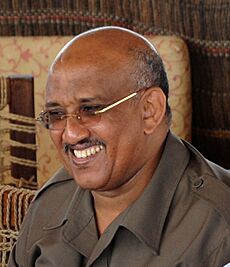
- Ayanleh Souleiman: A professional athlete.
- Lula Ali Ismaïl: A film director from Djibouti and Canada.
- Aïcha Mohamed Robleh: A writer.
- Jamal Abdi Dirieh: An athlete.
- Fadumo Ahmed Dhimbiil: A musician.
- Moumin Guelleh: An athlete.
- Abdourahman Waberi: A novelist.
- Mohamed Ali Fourchette: A musician.
- Yacin Elmi Bouh: A politician.
- Xabiiba Balbalaaf: A musician.
- Dileita Mohamed Dileita: A former Prime Minister of Djibouti.
- Mohamed Ali Mohamed: A politician.
- Abdi Waiss Mouhyadin: An athlete.
- Choukri Djibah: A politician and activist for women's equality.
See also
 In Spanish: Yibuti (ciudad) para niños
In Spanish: Yibuti (ciudad) para niños


